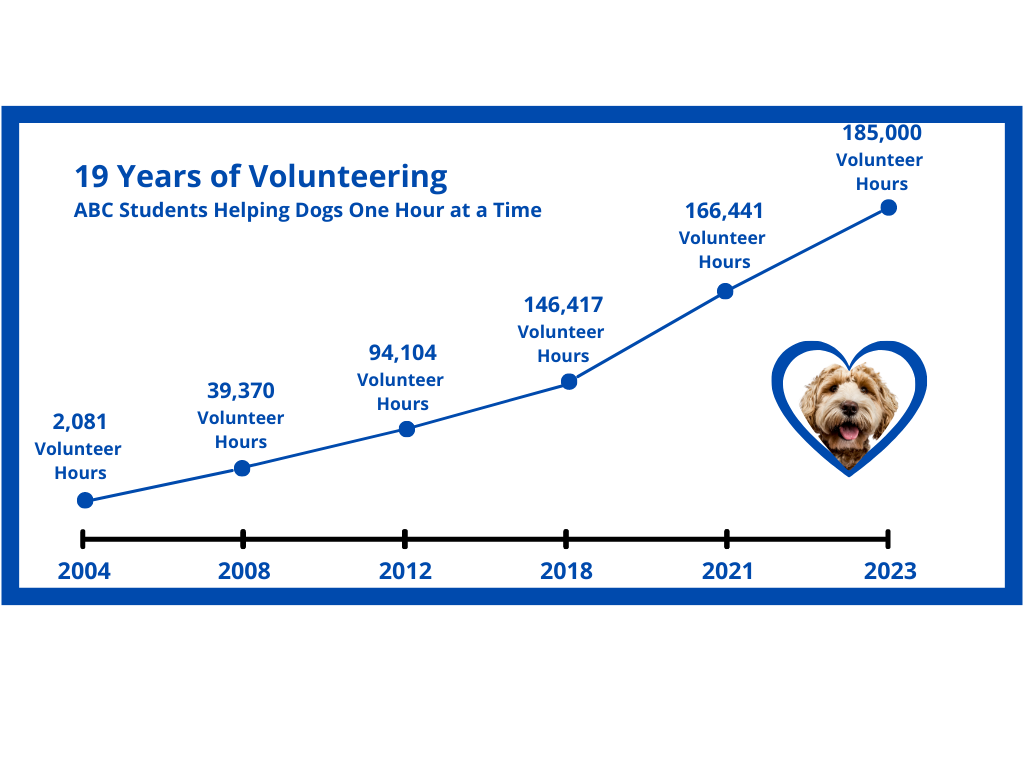Dog obedience training saves the lives of shelter dogs. By teaching basic obedience to shelter animals and helping curb unwanted behaviors like jumping on people, barking, or leash-pulling, their chances of being adopted go way up.
The students in our dog training program have great love for animals, and they know the clock is ticking for shelter dogs. The statistics break their hearts. In animal shelters, 56% of dogs are euthanized. Around 2.4 million animals euthanized in shelters were healthy and could’ve been saved and adopted1.
You can help! One of the primary reasons owners surrender their dogs is due to simple behavior problems, such as housebreaking and chewing. This is why Animal Behavior College and our students are committed to helping shelter dogs find their forever homes through the “Students Saving Lives” campaign.
Dog Training Students Get Hands-On Experience
The “Students Saving Lives” campaign is part of our Dog Trainer Program. While students are preparing for their future animal jobs, ABC asks them to volunteer a minimum of 10 hours at a local animal shelter, humane society or rescue organization. We are proud to say that more than 90% of our dog training students pledge their time to this cause. At shelters and humane societies across the country, you can find ABC students training and socializing dogs to increase their chances of being adopted. ABC dog trainer students apply what they’ve learned and use positive reinforcement dog training techniques to change shelter dogs’ behavior.



“The ABC students who have participated at the Toledo Area Humane Society with me have made a great difference in dogs being adopted,” says ABC Mentor Trainer Jane Hufstader. “There were several dogs that were difficult as far as jumping and just showing rude behavior, such as grabbing for toys or treats. The students worked very hard on changing those behaviors.”
Since 2004, ABC dog trainer students have volunteered more than 185,000 hours of their time to train and socialize shelter dogs. As our student body grows, so does the number of volunteer hours. Be part of the solution and help dogs find their forever homes!

How Training a Dog Can Save a Life
96% of dogs entering animal shelters have never received any dog obedience training, according to Petfinder2. Of those dogs, 47.7% are between 5 months and 3 years of age. This is an important animal shelter statistic because even though you can “teach an old dog new tricks,” a younger dog typically has had his bad habits for a shorter period of time, making training easier.
It’s important to understand the responsibility that comes with adopting a dog, or gifting a child with a dog. Dogs aren’t born knowing human language or human verbal cues; these are learned behaviors. For example, when two dogs make direct eye contact, this can be perceived as a challenge or a threat. Whereas, when two people make direct eye contact, it’s considered a form of normal social behavior.

Other reasons that dogs might end up in animal shelters include moving where the new landlord doesn’t allow pets and the increasing cost of pet care. While these are reasons we can’t control, we can help control whether or not a dog is properly trained, thus making him more attractive to potential adoptive families.
Common pet behavior issues can easily be resolved through positive reinforcement dog training. ABC’s dog training philosophy focuses on rewarding dogs for performing the correct behavior.
A few ways our students help increase dog adoption rates during their volunteer time at shelters include:
- Teaching dogs to walk calmly on leash
- Teaching dogs how to politely greet potential adoptive families by not jumping on or barking at them
- Teaching dogs basic obedience cues
“Now that I have started the ABC program I can’t wait to apply positive training methods to a number of dogs I see at the shelter I work at. I am looking forward to seeing drastic changes and really hoping to see a faster increase in the adoption of cruelty case dogs,” says ABC dog trainer student Tracy Vail.
Animal Shelters
Despite the best intentions of the family, a good number of dogs still end up in local shelters because they were never properly trained. These dogs can either end up in a kill shelter or no-kill shelter.
What is the Difference Between Kill Shelters and No-Kill Shelters?
The primary difference between kill shelters and no-kill animal shelters are their euthanasia policies and admissions policies.
Kill Shelters

Kill shelters, or open-admission shelters, have traditionally euthanized pets to manage animal population at the facility when they run out of space. More progressive kill shelters are managing population through fostering and high-volume adoption.3 These animal shelters accept all animals, including owner relinquishments and strays. Consequently, kill shelters tend to fill up with more pets than can be adopted, which often leads to higher euthanasia rates.
No-Kill Animal Shelters
Animal shelters are considered no-kill when they save at least 90% of the homeless animals they take in, according to Best Friends Animal Society4. No-kill animal shelters only euthanize pets that are either terminally ill or unable to be rehabilitated.
No-kill animal shelters are not open-admission. These animal shelters only accept animals that have gone through a screening process and meet certain criteria. This admissions policy creates an environment where more pets are being adopted.
Help Dogs While Getting Animal Training Career Experience
Our “Students Saving Lives” campaign is only growing as more students donate their time to helping dogs in their local shelters. If you’re interested in making a positive impact on shelter dogs, enroll in our Dog Trainer Program.
Sources:
1. PetKeen.com
2. Petfinder
3. Best Friends Animal Society
4. Best Friends Animal Society




